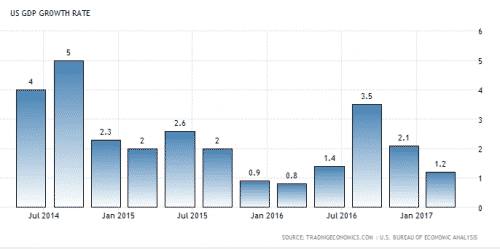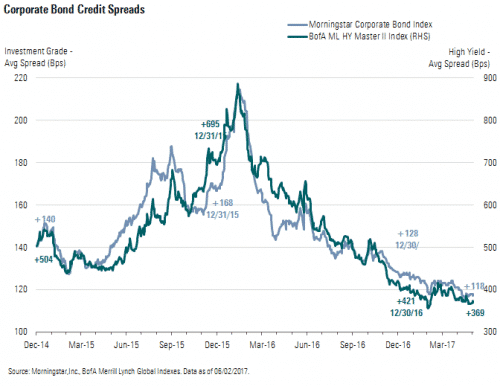What are credit markets signalling about the US economy?
The US economy has been very resilient during this post-crisis business cycle, as we are now into our ninth year of economic expansion. Soon we could hit a record for the length of an expansion. Yet, with that backdrop, 10-year Treasury yields were at 2.13% this morning – even as the Fed signals more hikes to come in 2017 as well as reverse QE. I think the bond market is signalling continued low growth and low inflation. Some thoughts below
The Great 2016 Recession Scare
Remember the recession scare we had last year? I talked about this in March. But let’s give a full re-count here because people have forgotten where we were.
If you recall, in December, as 2015 came to a close, the Fed hiked rates for the first time in 9 1/2 years. Not only did the Fed hike, it produced the famous dot plot, showing 4 more interest rate hikes in 2016 and 4 in 2017. This was a mistake.
I was uneasy about this move right from the start because the timing was all wrong. I said it created the potential for recession because the data did not support a hike — especially in the face of a massive decline in oil prices and the attendant energy capex bust. Even after the Fed hiked, oil prices continued to fall, and energy capex with it. The final reading of first quarter US GDP growth came in at a measly 1.4% on the heels of 0.9% and 0.8% growth in the 2 previous quarters. That’s three consecutive quarters of stall speed numbers.
GDP growth was slowing. Job growth was visibly slowing too. In short, the economy was on its knees.
So I went on recession watch in February, writing a post on how the Fed could cause recession in 2016. And here’s what I was saying:
“Now we have reached a point where the confluence of energy capex shortfalls, the impact of a strong dollar on earnings and exports and an incipient inventory purge has put the US economy in stall speed…
…the Fed is desperate to raise rates and is ignoring the material slowdown in US growth. Their monetary policy is, therefore, extremely dangerous and could lead to a credit crunch and recession in 2016, one that would be the result of policy error.
Markets front-run Fed policy moves by anticipating where the economy is heading based on the prevailing economic environment, the Fed’s anticipated reaction function, and the intersection of Fed policy and the real economy to influence future economic growth…
[…]
Where we are now is where markets recognize the Fed’s policy message is incompatible with robust future growth and will force the Fed to keep rates lower for longer further into the future. That’s what currency markets are saying. That’s what high yield markets are saying. That’s what Treasury markets are saying. And that’s what equity markets are saying.”
My conclusion was that the Fed would be forced to delay their hikes to avoid recession. The dot plot was simply wrong.
And indeed there was only one hike in 2016. The Fed only resumed rate hikes this past December. But let’s be clear on why the Fed changed its tune: though nothing in the data said recession, it was clear that the economy had stalled and four rate hikes would have put us over the top. The Fed eventually saw this and delayed.
The Resilient US Economy
So what’s the takeaway here? I come away with a couple of positive ones. First, the Fed actually is data dependent. They saw a material slowdown taking shape, understood their reaction function was inappropriate, and changed course. For me, this is good news because it reduces the likelihood that the Fed will kill this upturn prematurely.
But the 2016 recession scare also says something good about the US economy – and that’s that it is remarkably resilient. We had a massive capital expenditure bust in the energy sector that sucked tens of billions of dollars out of the economy. The scenario had end of cycle dynamics to it from where I sat in 2016. And yet, despite all of the turmoil in energy, despite the unexpected Brexit vote, despite the Deutsche Bank bankruptcy scare and all the other shocks we took, the US economy kept growing.
Yes, the Fed’s change of heart was helpful. Yes, the pick up in oil prices from January helped too; it was perhaps the decisive factor. Nevertheless, the underlying message I took away from 2016 was of a US economic juggernaut overcoming all odds to prove the naysayers wrong.
If you look at past US business cycles, the longest expansion trough to peak was exactly 10 years from March 1991 to March 2001. If you factor in the short 8-month recession, then you get a peak to peak number of 128 months.
Now, this month marks 8 years for the current expansion. So right now we are on course to pass the expansion record in 2019. The peak to peak number of 128 months would be history if this business cycle makes it to September 2019. The expansion record would get broken two months earlier in July.
But will we make it there?
What Credit Markets Say
I can’t look far enough ahead to say what will happen in the coming two years. So I don’t know if we’ll break the record. What I can say is that the credit markets have been right all along the way. At important points in time when the Fed signalled policy changes, credit markets have correctly interpreted how likely those changes were going to be. The perfect example is the initial rate hike path set out in December 2015. This was totally wrong and the credit markets were telling us so, right from the start.
What credit markets are saying right now screams secular stagnation. Here’s why.
Equity markets have been on a tear due to high operating margins, stock buybacks and multiple expansion combining to pull shares up. And this paints a bright economic future that gives the Fed cover to hike rates repeatedly. And on the surface, one would think this outcome implies higher economic growth. And if this share price actually did indicate higher economic growth, not just higher profits, then US government bond yields would be rising due to future rate hike expectations as nominal GDP would be boosted by full employment and increased inflation. But that’s not what’s happening at all.
Instead, the US 10-year bond is pretty close to 2% and the yield curve is flattening. So, what I see the bond markets saying is that future rate hikes by the Fed will be limited due to low nominal GDP growth aka secular stagnation. Now, bond markets are not saying doom is around the corner. Remember, investment grade and high yield bond market spreads have tightened and corporate bond yields are near historic lows.
Source: Morningstar
So all is good in the corporate world and in the world of systemic financial risk right now. But you can’t square the circle of rate hikes, reverse QE, low risk spreads and relatively robust equity markets with continued low long-term Treasury yields unless you insert the term ‘secular stagnation.’
So here’s how I think things will play out.
The Fed will continue to hike and the yield curve will continue to flatten. The Fed may even begin to reduce its balance sheet later this year. At some point, either the yield curve flattening will stop or the Fed will stop. During the energy capex bust, the Fed already showed us it is responsive to data. And so to the degree the yield curve continued to flatten, I believe it would show up as poor economic data and the Fed would be forced to yield. Alternatively the flattening could end due to a re-acceleration of growth, ending the whole speculation about secular stagnation, at least temporarily.
If I had to pick the likelier scenario, I would pick the one in which the credit markets were right and the Fed was wrong. And that means the Fed will pause. This will occur before 2017 is over and we’ll just have to see where the economy is at that time. We could still break the expansion record. But we won’t do so in an economy growing 3 and 4% a year. Bond markets are telling us that.


Comments are closed.